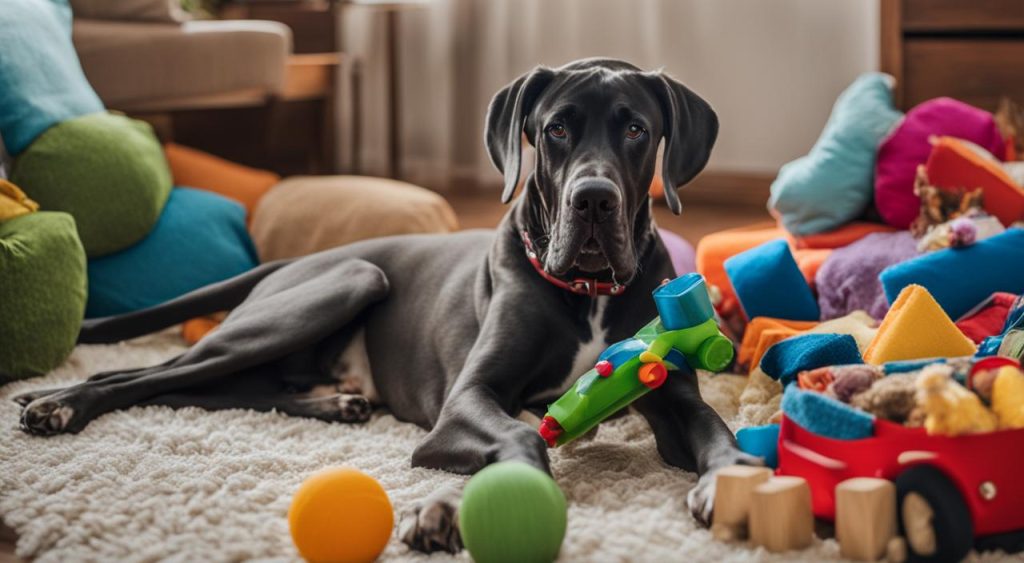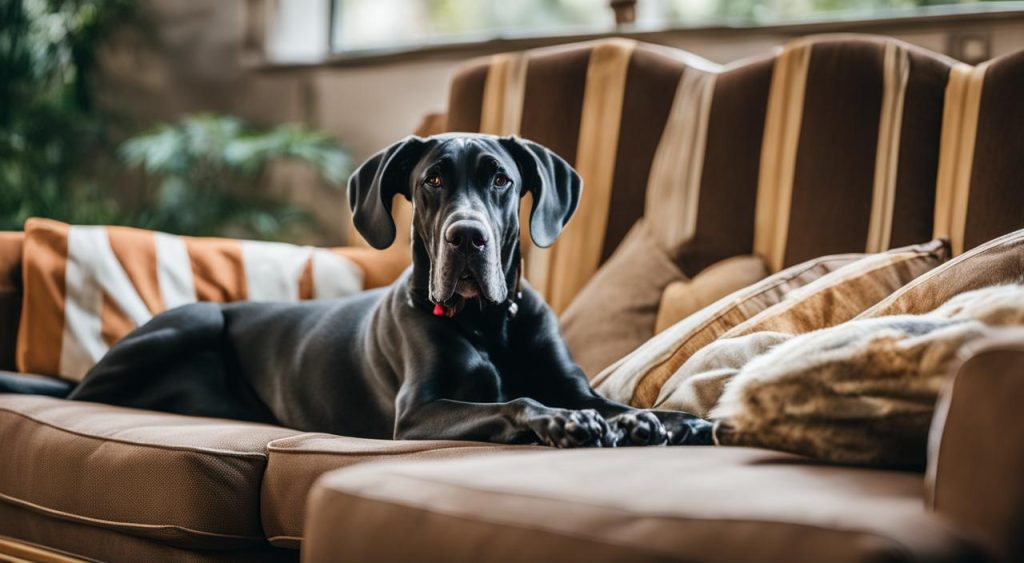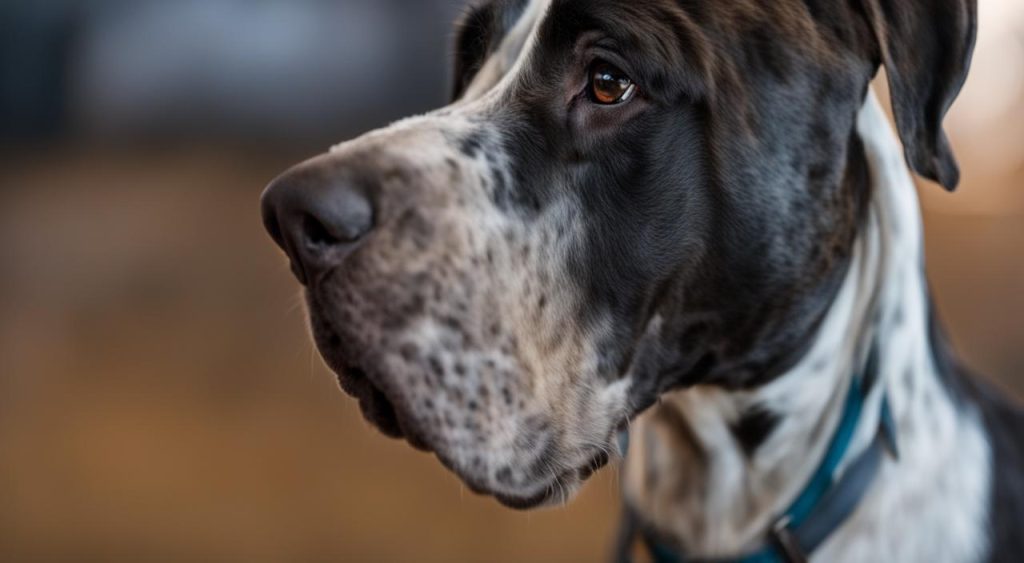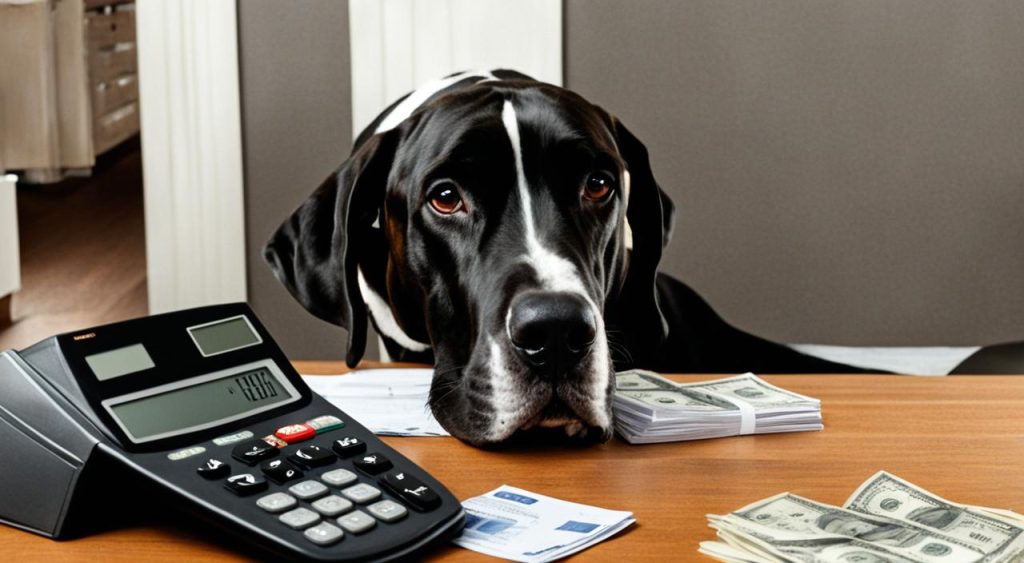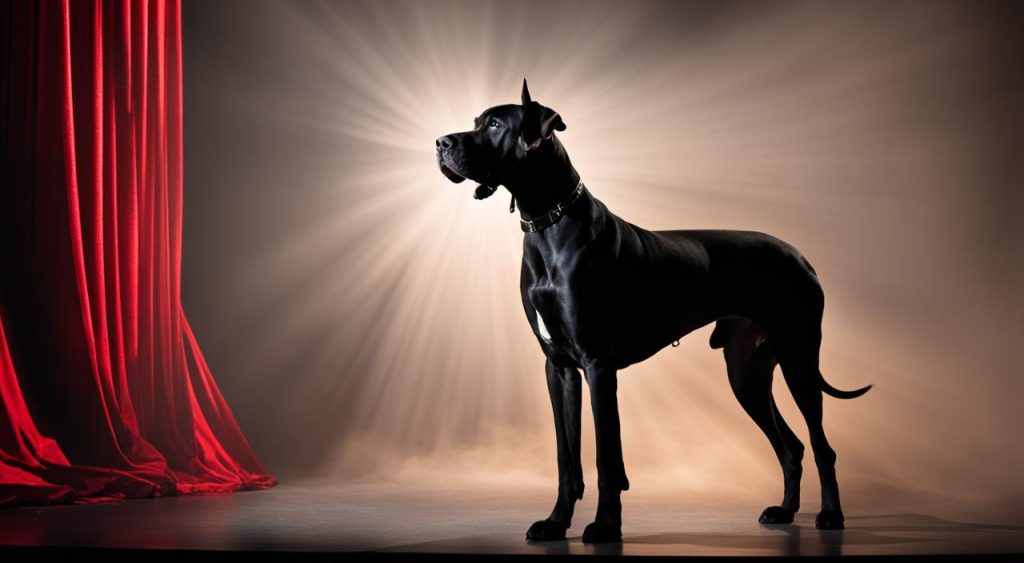Curious about when your Great Dane will calm down? Understanding your Great Dane’s temperament and behavior is key to managing their energy levels and promoting a calm and balanced demeanor. While most Great Danes start to calm down around the age of 2, there are various factors that can influence their maturity and energy levels.
Great Dane puppies are known for their playful and energetic nature. As they grow older, they gradually transition from puppyhood to adulthood, and their energy levels begin to decrease. However, it’s important to note that individual differences exist, and some Great Danes may take longer to calm down.
Factors such as exercise, boredom, and anxiety can have an impact on a Great Dane’s energy levels and behavior. Regular exercise is essential for burning off excess energy and preventing destructive behavior. Providing mental stimulation through playtime and interactive toys can also help tire out your Great Dane and promote relaxation.
Additionally, boredom can contribute to hyperactivity in Great Danes. Ensuring they have a variety of toys and activities to keep them engaged can help prevent restlessness. Anxiety can also play a role in a Great Dane’s energy levels. If your Great Dane displays signs of anxiety, such as excessive pacing or restlessness, it’s important to address these issues through training and, in some cases, seek professional help.
Creating a calm environment is crucial for a Great Dane’s overall well-being. Designate a calm and quiet space where they can retreat to when they need some downtime. Additionally, demonstrate calm and assertive behavior yourself, as dogs often mirror the energy and behavior of their owners.
Key Takeaways:
- Most Great Danes calm down around the age of 2, but individual differences exist.
- Exercise is essential for managing a Great Dane’s energy levels and promoting a calm temperament.
- Boredom and anxiety can contribute to hyperactivity in Great Danes, so providing mental stimulation and addressing anxiety issues are important.
- Create a calm environment by designating a quiet space and demonstrating calm behavior yourself.
- If you have concerns about your Great Dane’s energy levels or behavior, consult with a veterinarian or professional trainer.
Factors Affecting Great Dane Energy Levels
Several factors can affect a Great Dane’s energy levels and behavior. When they are young, Great Dane puppies tend to be more hyper and curious about their surroundings. Lack of exercise can also contribute to hyperactivity, as Great Danes are a high-energy breed that requires regular physical activity. Additionally, boredom can lead to destructive behavior, as Great Danes may seek ways to entertain themselves. Lastly, anxiety can cause hyperactivity in Great Danes, so it’s important to address any underlying anxiety issues through training and, in some cases, medication.
During the puppy stage, it’s natural for Great Danes to exhibit high levels of energy. They are curious about their surroundings and eager to explore. Providing them with enough physical and mental stimulation is crucial during this time to prevent excessive hyperactivity. Regular exercise routines, such as daily walks and play sessions, can help burn off their energy and promote a more balanced behavior.
Proper training is also key in managing a Great Dane’s energy levels. By teaching them basic commands and establishing boundaries, you can help them understand what is expected of them. This will not only help reduce hyperactive behavior but will also contribute to their overall development and well-being.
Adolescence can be a challenging phase for Great Danes, as they go through physical and hormonal changes. This can often result in increased energy levels and a rebellious attitude. Consistency in training and socialization is crucial during this stage to help shape their behavior and prevent behavioral issues from developing.
Socialization is an important aspect of a Great Dane’s development. Exposing them to various environments, people, and other animals from a young age can help them become well-adjusted and confident adults. This also contributes to a more balanced energy level and behavior.
It’s important to note that each Great Dane is unique, and factors such as genetics and individual temperament can also influence their energy levels. If you have concerns about your Great Dane’s behavior or energy levels, consulting with a professional trainer or veterinarian can provide valuable guidance and support.
Tips for Calming Down a Great Dane
When it comes to calming down a Great Dane, there are several effective strategies you can try. By incorporating these tips into your routine, you can help your beloved companion develop a calm and balanced demeanor.
Regular Exercise: Great Danes are a high-energy breed, so providing them with regular exercise is crucial. Engage in activities such as long walks, play sessions, and mentally stimulating games to help burn off excess energy. Aerobic exercise is particularly beneficial for promoting a calmer state of mind.
Mental Stimulation: In addition to physical exercise, Great Danes also require mental stimulation to stay calm and content. Incorporate puzzle toys, treat-dispensing toys, and training sessions into your Great Dane’s day to engage their mind and prevent boredom.
Spaying or Neutering: Consider spaying or neutering your Great Dane, as this can help reduce hormone levels that contribute to hyperactivity and excess energy. Consult with your veterinarian to determine the appropriate timing for this procedure in order to achieve the best results.
Create a Calm Environment: Setting up a calm and peaceful environment can have a significant impact on your Great Dane’s behavior. Establish a designated relaxation spot in your home where your dog can retreat to when they need some quiet time. Use soft bedding and provide comforting toys to create a serene atmosphere.
Lead by Example: Dogs often mirror their owners’ behavior, so it’s essential to maintain a calm and patient demeanor around your Great Dane. Avoid loud noises, sudden movements, and avoid exhibiting any signs of anxiety or stress. By setting a positive example, you can encourage your Great Dane to adopt the same calm behavior.
By implementing these tips, you can create a harmonious and calm environment for your Great Dane. Remember that every dog is unique, so it may take some trial and error to find the strategies that work best for your particular dog. Patience, consistency, and love will go a long way in helping your Great Dane achieve a calm and balanced temperament.
Conclusion
Great Danes, known for their majestic appearance and gentle nature, can have varying energy levels and temperaments. While most Great Danes begin to calm down around the age of 2, it’s important to remember that individual differences and external factors play a significant role in their behavior.
Factors such as training, exercise, and anxiety can impact a Great Dane’s energy levels and temperament. Understanding these factors is crucial in helping your Great Dane develop a balanced and well-behaved demeanor.
By implementing strategies to promote calmness, such as regular exercise, mental stimulation, and providing a tranquil environment, you can contribute to a harmonious relationship with your Great Dane. Additionally, seeking guidance from a veterinarian or professional trainer can provide valuable insights and support regarding your Great Dane’s energy levels and behavior.
Remember, each Great Dane is unique, and it may take time and patience to find the right approach for your furry companion. With proper care and attention, you can help your Great Dane thrive and enjoy a balanced and fulfilling life.

